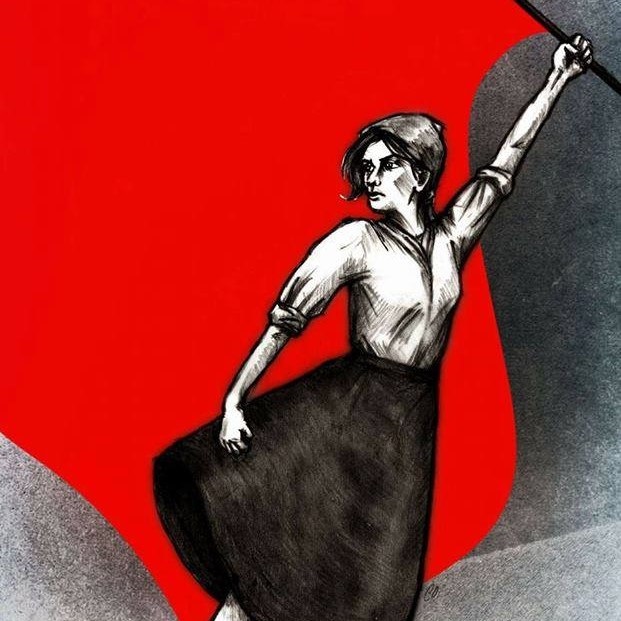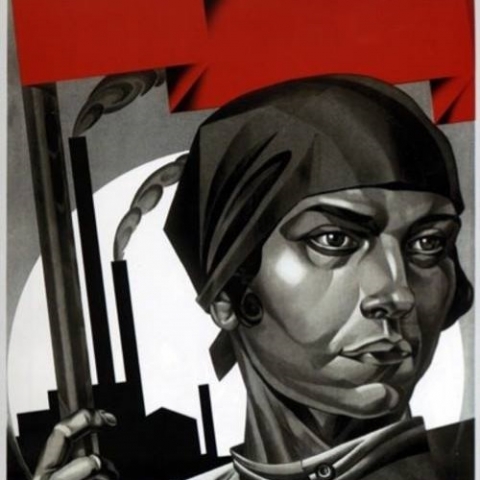
Every year on March 8th, International Women’s Day is celebrated all over the world. Today, it has become what is essentially a day to raise awareness about the oppression of women. This year, it has particular significance because it is also the anniversary of the beginning of the Russian Revolution of 1917. Most people are not aware of the fact that on March 8th 1917 it was actually women who started the events that created the revolution. This began a revolutionary process that brought the working class to power, allowing for spectacular advancements for women.
Women workers, the vanguard of the Russian Revolution!
On February 23rd 1917 – March 8th in the Gregorian calendar – it was women workers who were the first the take to the streets of Petrograd, triggering a movement that would lead to the fall of the Tsar a week later.

Women textile workers, following attempts of the Tsarist government to ban demonstrations on Women’s day, refused to work and went on strike. Taking to the streets and sending delegates to the other factories, they sparked the revolution. Against all odds, and without any prior plan, a mass strike broke out. Around 90,000 workers were on strike for the first day. Women were demanding bread, an end to the war and an end to Tsarism. In the following days, the strike became general and a soviet was founded in Petrograd. The fall of Tsarism became an inevitability when the army came over to the side of the revolution.
Women workers played an essential role, fraternizing with the soldiers and inciting them to turn their bayonets on their common enemy. This key role of women in the Russian Revolution is in fact nothing new. Women are quite often the first to enter the struggle and the last to leave. As an oppressed group, they have everything to win from the abolition of the capitalist system and the struggle for the establishment of socialism. Conversely, they are the first to suffer from the defeat of the revolution and the liquidation of its gains. The Russian Revolution is no exception here.
The revolution and the condition of women
After eight months of struggle between the soviets – representing the workers, peasants and soldiers – and the provisional government – representing the bourgeoisie – the Bolshevik Party organized the seizure of power by the soviets in October 1917 (November in the Gregorian calendar). The soviet regime made it a goal to put in place the conditions for the genuine liberation of women. After the revolution, there were several laws adopted making it so that women had the same rights as men. There was a law that stipulated that a woman must be paid the same wage as a man. For the first time in history, a woman was part of the government:
Alexandra Kollontai, the first People’s Commissar of Social Welfare. In December 1917, a public insurance fund was created, with no deductions from workers wages. Six weeks after the revolution, civil marriage was legalized. Spouses now had the same rights as one another and divorce was legal and accessible to all.

In 1918, a Ministry for the Protection of Maternity and Childhood was established. This led to reforms such as 16 weeks of maternity leave, exemption from overly burdensome work, banning of transfers, layoffs and night work for pregnant and postpartum women as well as access to clinics specializing in maternity, counseling services and daycares. Measures to socialize domestic work were introduced so that this burden would no longer only fall on women, isolated in their homes. In addition to the aforementioned daycares, restaurants, laundromats, medical dispensaries and hospitals were developed.
The distinction between a legitimate and an illegitimate child was abolished by the soviet regime. Starting in 1920, women had the right to abortion. Russia became the first country to grant this right, almost 53 years before the United States and 71 years before Canada! Women were beginning to take control of their bodies and over society. They took part in it through workers’ democracy.
All of these reforms would never have been possible, so early in history, under the capitalist system. Soviet power, in an economically backwards country where the oppression of women and minorities was possibly among the most fierce in the entire world, achieved in a few years what the capitalists in other countries took decades to concede under massive pressure from the struggle of the working class and of women. At a time when Donald Trump’s clique in 2017 is trying to restrict access to abortion and we are faced with repeated attacks on women and minorities all over the country, the Russian Revolution is an inexhaustible source of inspiration.
The return of capitalism in Russia: a catastrophe for women
The Stalinist reaction, through a series of counter reforms, represented a big step back at the end of the 1920s and the beginning of the 1930s. The soviet bureaucracy that had formed needed stability, and this went hand in hand with reinforcing the nuclear family unit inherited from the past – that is to say reducing women to the role of a slave for men. In 1934, prostitution became illegal and punishable by at least eight months in prison. Divorce became less accessible and more expensive. The Stalinist regime went as far as criminalizing abortion in 1936, saying that it was supposedly not necessary in a society where women were liberated and where “socialism had been achieved.”
In spite of all of the detrimental effects of Stalinism, women in the Soviet Union made huge leaps towards equality. The revival of the soviet economy after the Second World War allowed for significant gains. Women constituted 49% of students in higher education in 1970; only Finland, France and the United States had also surpassed the 40% mark. Pregnant women could benefit from a reduction in their workload and paid maternity leave. As well, there was an increase in daycare spaces, an increase in life expectancy and a drop in infant mortality. All of this progress was the fruit of the planned economy, an economy freed from the need to satisfy the investors’ thirst for profit.
The return of capitalism in Russia in the 1990s undermined, one after another, all of the advances made by women following the revolution. Capitalism has brought back all of the evils usually associated with it: family oppression, unemployment, prostitution and homelessness. Women were the first to be laid off, the first to suffer wage cuts and were the ones who returned to the home as a result of the draconian cuts in social services. The rise in unemployment meant that women accounted for almost 70% of the unemployed and up to 90% in some regions. The decrease in women’s wages, which fell from 70% to 40% of that of men after 1989, increased their material dependence on men. There was also a huge increase in violence against women.
In the 1990s, the bourgeoisie jubilantly proclaimed the “end of history” and the victory of liberal democracy. What has been accomplished in Russia since then? Russia is now dominated by gangsters, inequality has never been so high, and the condition of women and other oppressed groups has been getting worse and worse. A direct attack against women has recently occurred: the Russian Duma (parliament) has decriminalized domestic violence at the first offense and there are no serious consequences. Previously, such acts could be punished by two years in prison. The responsibility is now on the victim who must personally provide a record of evidence, and this may have the effect of increasing the difficulty for the victims to bring to justice their aggressor. According to Duma spokesman Vyacheslav Volodin, the law “would help build strong families”! Twenty-five years after the end of the Soviet Union, this new law is a tragic testimony to the position of women made possible by the victory of “democracy”.
Take inspiration from 1917
Today, under capitalism, social services such as those mentioned above exist and mitigate the burden on women, but these programs are at risk of being abolished or cut severely as austerity is on the order of the day in all countries. Women still do not have the same wages as men for equal work. They are still forced to perform the majority of domestic tasks and are underrepresented in the political and cultural spheres.
The October 1917 revolution not only wanted formal equality between men and women, but it wanted to create the material conditions to give women real access to all political, economic and cultural fields of society. We are facing the same task today. As long as a system based on exploitation persists, as long as the family in its present form exists, women will not be able to free themselves completely from their chains.
Today, the same as one hundred years ago, women play a leading role in the struggle against oppression and exploitation. The Women’s March against Donald Trump on January 21 was a clear demonstration of this. And today, as was the case a hundred years ago, we must link the struggle of against women’s oppression with the wider struggle for the overthrow of the established order, for the overthrow of capitalism. There must be a new foundation for society, through which the daily struggle for survival, competition between workers and the slave mentality will be destroyed, a society where truly harmonious relations between human beings will become the standard. Women in the struggle for emancipation will find in the Russian Revolution of 1917 an inspiring example from which we must draw lessons in order to accomplish the socialist transformation of society.
